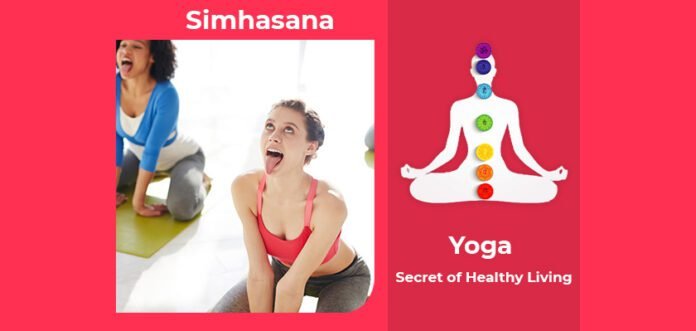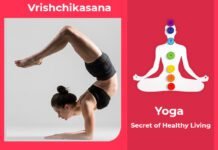What is Simhasana
Simhasana Placing the palms on the knees, spreading out the fingers (and) opening the mouth wide, one should gaze at the tip of the nose and be well (composed).
- This Simhasana, adored by ancient yogis.
Also Know as: Lion Posture, Tiger Pose, Singh Asan, Singa or Singha Asana, Sinhasana
How to start this Asana
- Sit in Vajrasana .
- Now raise your buttock a little and cross the heel and toes of the right leg over that of left leg.
- Sit on the heels and place both hands on the respective knees.
- Spread out the fingers.
- Bring out the tongue as much as possible.
- Gaze should be on Nasal.
How to end this Asana
- While returning back to the original position, take the tongue in, release the tension, loosen your hands and come back to the original position.
Video Tutorial
Benefits of Simhasana
According to research, this Asana is helpful as per below(YR/1)
- Relieves tension in the chest and face.
- An often-overlooked benefit of Simhasana is that it stimulates the platysma, a flat, thin, rectangular-shaped muscle on the front of the throat.
- When the platysma muscle is contracted, it pulls down the corners of the mouth and wrinkles the skin of the neck.
- Simhasana helps keep the platysma firm as we age.
- According to traditional texts, Simhasana destroys disease and facilitates the three major bandhas (Mula, Jalandhara, Uddiyana).
Precaution to be taken before doing Simhasana
As per several scientific studies, precautions need to be taken in diseases mentioned as per below(YR/2)
- If you have a knee injury, always be cautious in flexed-knee sitting positions and, if necessary, sit on a chair to do the pose.
So, consult your doctor if you have any of the problem mentioned above.
Histroy and scientific base of Yoga
Due to the oral transmission of sacred writings and the secrecy of its teachings, yoga’s past is riddled with mystery and confusion. Early yoga literature were recorded on delicate palm leaves. So it was easily damaged, destroyed, or lost. Yoga’s origins may be dated back over 5,000 years. However other academics believe it could be as old as 10,000 years. Yoga’s lengthy and illustrious history may be split into four distinct periods of growth, practise, and invention.
- Pre Classical Yoga
- Classical Yoga
- Post Classical Yoga
- Modern Yoga
Yoga is a psychological science with philosophical overtones. Patanjali begins his Yoga method by instructing that the mind must be regulated – Yogahs-chitta-vritti-nirodhah. Patanjali does not delve into the intellectual underpinnings of the need to regulate one’s mind, which are found in Samkhya and Vedanta. Yoga, he continues, is the regulation of the mind, the constraint of the thought-stuff. Yoga is a science based on personal experience. The most essential advantage of yoga is that it helps us to maintain a healthy bodily and mental state.
Yoga can help to slow down the ageing process. Since aging starts mostly by autointoxication or self-poisoning. So, we can considerably limit the catabolic process of cell degeneration by keeping the body clean, flexible, and properly lubricated. Yogasanas, pranayama, and meditation must all be combined to reap the full advantages of yoga.
SUMMARY
Simhasana is helpful in increase flexibility of muscles, improves shape of the body, reduce mental stress, as well improves overall health.




